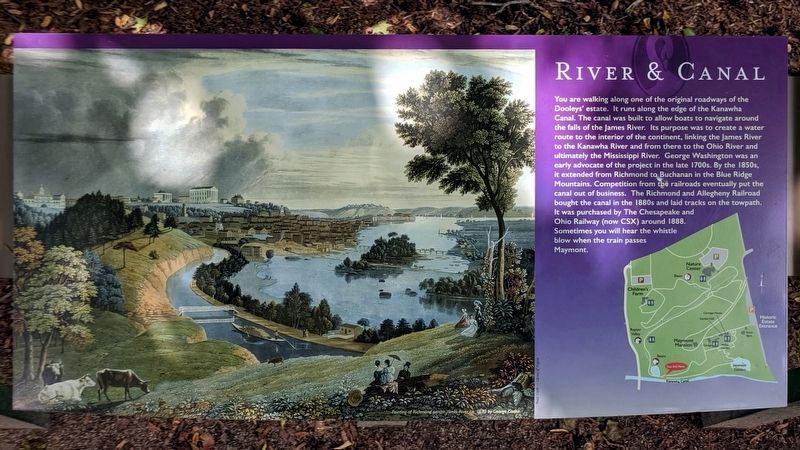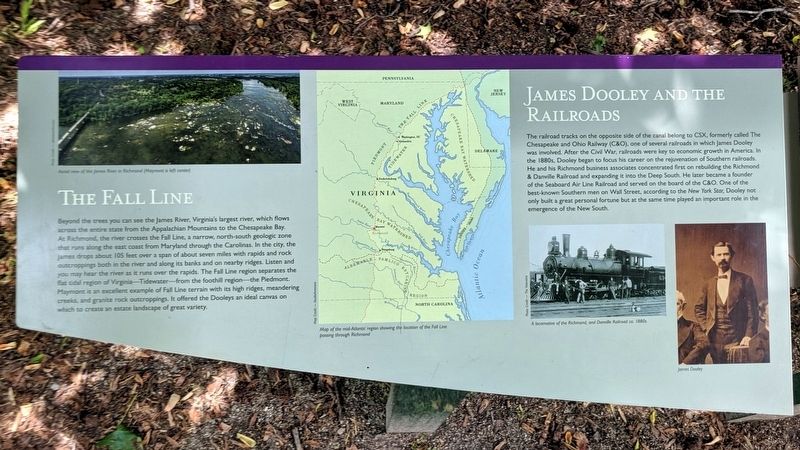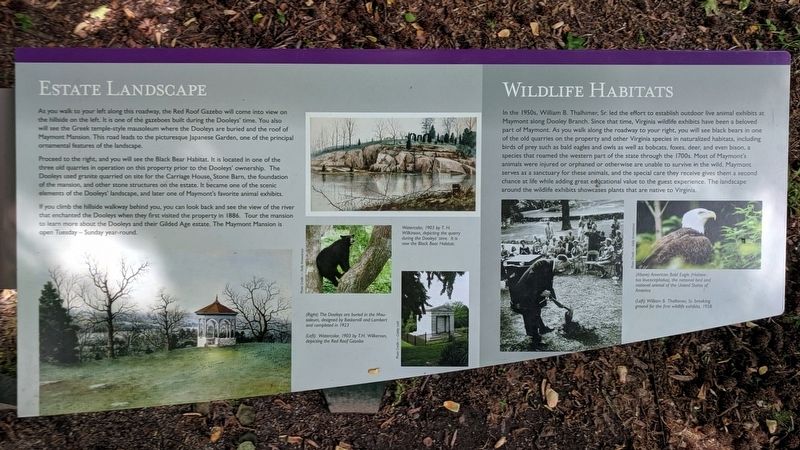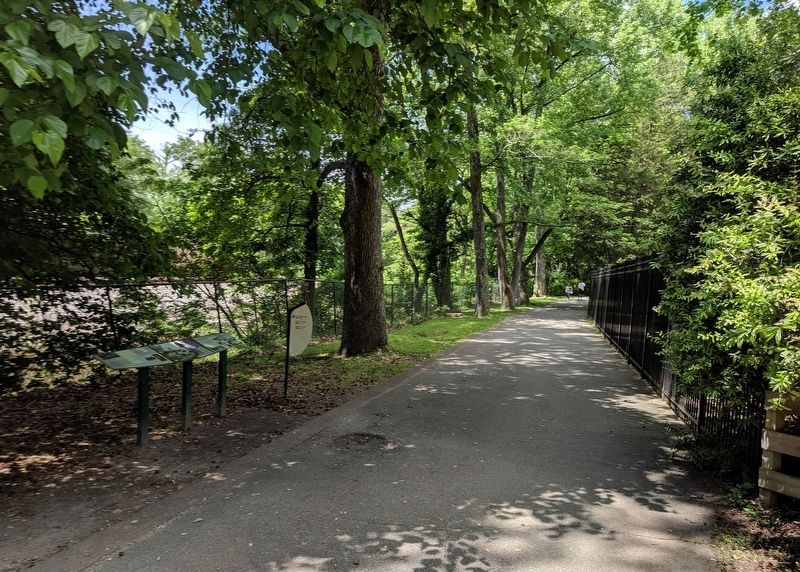Maymont in Richmond, Virginia — The American South (Mid-Atlantic)
River & Canal
You are walking along one of the original roadways of the Dooleys' estate. It runs along the edge of the Kanawha Canal. The canal was built to allow boats to navigate around the falls of the James River. Its purpose was to create a water route to the interior of the continent, linking the James River to the Kanawha River and from there to the Ohio River and ultimately the Mississippi River. George Washington was an early advocate of the project in the late 1700s. By the 1850s, it extended from Richmond to Buchanan in the Blue Ridge Mountains. Competition from railroads eventually put the canal out of business. The Richmond and Allegheny Railroad bought the canal in the 1880s and laid tracks on the towpath. It was purchased by The Chesapeake and Ohio Railway (now CSX) around 1888. Sometimes you will hear the whistle blow when the train passes Maymont.
Painting of Richmond on the James River ca. 1830 by George Cooke Library of Virignia
(left panel)
The Fall Line
Beyond the trees you can see the James River, Virginia's largest river, which flows entire state from the Appalachian Mountains to the Chesapeake Bay. At Richmond, the river crosses the Fall Line, a narrow, north-south geologic zone that runs along the east coast from Maryland through the Carolinas. In the city, the James drops about 105 feet over a span of about seven miles with rapids and rock outcroppings both in the river and along its banks and on nearby ridges. Listen and you may hear the river as it runs over the rapids. The Fall Line region separates the flat tidal region of Virginia—Tidewater—from the foothill region—the Piedmont. Maymont is an excellent example of Fall Line terrain with its high ridges, meandering creeks, and granite rock outcroppings. It offered the Dooleys an ideal canvas on which to create an estate landscape of great variety.
James Dooley and the Railroads
The railroad tracks on the opposite side of the canal belong to CSX, formerly called The Chesapeake and Ohio Railway (C&O), one of several railroads in which James Dooley was involved. After the Civil War, railroads were key to economic growth in America. In the 1880s, Dooley began to focus his career on the rejuvenation of Southern railroads. He and his Richmond business associates concentrated first on rebuilding the Richmond & Danville Railroad and expanding it into the Deep South. He later became a founder of the Seaboard Air Line Railroad and served on the board of the C&O. One of the best-known Southern men on Wall Street, according to the New York Star, Dooley not only built a great personal fortune but at the same time played an important role in the emergence of the New South.
Aerial view of the James River at Richmond (Maymont left center)
Map of the mid-Atlantic region showing the location of the Fall Line passing through Richmond
A locomotive of the Richmond, and Danville Railroad ca. 1880s
James Dooley
(right panel)
Estate Landscape
As you walk to your left along this roadway, the Red Roof Gazebo will come into view on the hillside on the left. It is one of the gazeboes built during the Dooleys' time. You also will see the Greek temple-style mausoleum where the Dooleys are buried and the roof of Mansion. This road leads to the picturesque Japanese Garden, one of the principal features of the landscape.
Proceed to the right, and you will see the Black Bear Habitat. It is located in one of the three old quarries in operation on this property prior to the Dooleys' ownership. The Dooleys used granite quarried on site for the Carriage House, Stone Barn, the foundation of the mansion and other stone structures on the estate. It became one of the scenic elements of the Dooleys’ landscape, and later one of Maymont's favorite animal exhibits.
If you climb the hillside walkway behind you, you can look back and see the view of the river that enchanted the Dooleys when they first visited the property in 1886. Tour the mansion to learn more about the Dooleys and their Gilded Age estate. The Maymont Mansion is open Tuesday — Sunday year-round.
Watercolor, 1903 by T.H. Wilkinson, depicting the quarry during the Dooleys' time. It is now the Black Bear Habitat.
(Right) The Dooleys are buried in the Mausoleum, designed by and-Lambert and completed in 1923
(Left) Watercolor, 1903 by T.H. Wilkerson, depicting the Red Roof Gazebo
Wildlife Habitats
In the 1950s, William B. Thalhimer, Sr. led the effort to establish outdoor live animal exhibits at Maymont along Dooley Branch. Since that time, Virginia wildlife exhibits have been a beloved part of Maymont. As you walk along the roadway to your right, you will see black bears in one of the old quarries on the property and other Virginia species in naturalized habitats, including birds of prey such as bald eagles and owls as well as bobcats, foxes, deer, and even bison, a species that roamed the western part of the state through the 1700s. Most of Maymont's animals were injured or orphaned or otherwise are unable to survive in the wild. Maymont serves as a sanctuary for these animals, and the special care they receive gives them a second chance at life while adding great educational value to the guest experience. The landscape around the wildlife exhibits showcases plants that are native to Virginia.
(Above) American Bold Eagle (Halaeetus leucocephalus), the national bird and national animal of the United States of America
(Left) William B. Thalhimer, Sr. breaking ground for the first wildlife exhibits, 1958
Erected by Maymont Foundation.
Topics. This historical marker is listed in these topic lists: Animals • Parks & Recreational Areas • Railroads & Streetcars • Waterways & Vessels.
Location. 37° 32.021′ N, 77° 28.866′ W. Marker is in Richmond, Virginia. It is in Maymont. Marker can be reached from the intersection of Hampton Street and Pennsylvania Avenue, on the right when traveling south. Touch for map. Marker is at or near this postal address: 1700 Hampton Street, Richmond VA 23220, United States of America. Touch for directions.
Other nearby markers. At least 8 other markers are within walking distance of this marker. Maymont, Gilded Age Estate (approx. 0.2 miles away); James & Sallie Dooley (approx. 0.2 miles away); Historic Estate (approx. 0.2 miles away); a different marker also named Historic Estate (approx. 0.3 miles away); Byrd Park Pump House (approx. 0.3 miles away); Pumps and Parties (approx. 0.3 miles away); Richmond at the Falls (approx. 0.4 miles away); Breaking Stones with Feathers (approx. 0.4 miles away). Touch for a list and map of all markers in Richmond.
Also see . . . Maymont Foundation. (Submitted on May 11, 2019.)
Credits. This page was last revised on February 1, 2023. It was originally submitted on May 11, 2019, by Bernard Fisher of Richmond, Virginia. This page has been viewed 232 times since then and 15 times this year. Photos: 1, 2, 3, 4. submitted on May 11, 2019, by Bernard Fisher of Richmond, Virginia.



